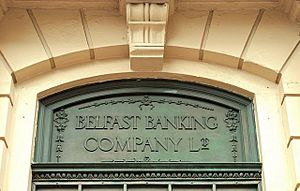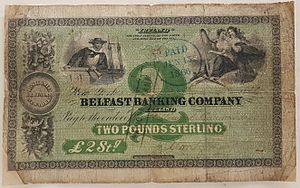Belfast Banking Company facts for kids
The Belfast Banking Company was an important bank in Northern Ireland. It began in 1827 when two older banks, Batt's (also known as The Belfast Bank) and Tennant's (The Commercial Bank), joined together. This bank mostly served customers in the Ulster area. After the Irish Free State was created, the Belfast Banking Company sold its branches in that new country to the Royal Bank of Ireland. In 1917, a larger bank called the London City and Midland Bank bought the Belfast Banking Company. Later, in 1970, it combined with the Northern Bank, which the Midland Bank also owned.
The Bank's Journey
The Belfast Banking Company officially started as a company on July 2, 1827. It was formed by combining the last two private banks in Belfast, Ireland. These were Batt's, which began in 1808, and Tennant's. When it started, the new company had 337 owners, called shareholders. It opened for business on August 1, 1827.
The bank worked in a similar way to the Northern Banking Company. However, it focused almost entirely on the Ulster region. The Belfast Banking Company did not open a branch in Dublin until 1892. Interestingly, it even had a branch in New York during the 1860s.
Changes Over Time
In 1917, the Belfast Banking Company was sold to the London City and Midland Bank. During the First World War, seventeen of the bank's staff members sadly died while serving in the British armed forces. They are remembered with a special window at St Anne's Cathedral in Belfast.
After Ireland became independent in 1922, the Belfast Banking Company sold its 20 branches in the new Irish Free State. These branches were sold to the Royal Bank of Ireland. By the 1920s, the bank was allowed to print its own banknotes in Northern Ireland. In 1927, to celebrate its 100th birthday, the staff raised £500. This money was used to name a hospital bed at the Royal Victoria Hospital after the bank forever.
Joining Forces
In 1965, the Midland Bank bought the Northern Bank. It then started plans to combine the two companies. This process was a bit tricky because both banks were allowed to print their own banknotes. If they created a brand new company, it might not have had the same special powers.
The merger finally happened on July 1, 1970. This was made possible by a special law passed by the British parliament. The new combined company kept the name Northern Bank. On that day, the bank asked its staff to wear red carnations. This was to celebrate what they called a "happy and memorable day."
After the merger, the new company had 287 branches. Many of these branches were very close to each other, sometimes on the same street. So, they closed some branches to make things more efficient. The company was later bought by the National Australia Bank. Today, it is owned by Danske Bank and operates under their name.




